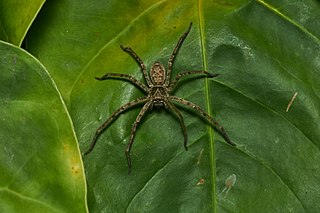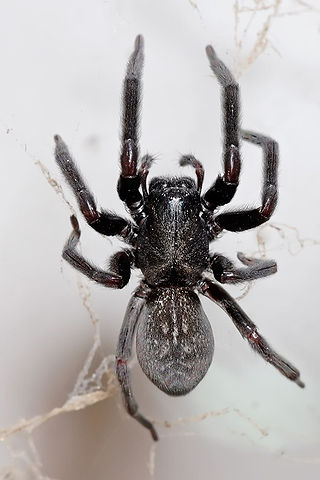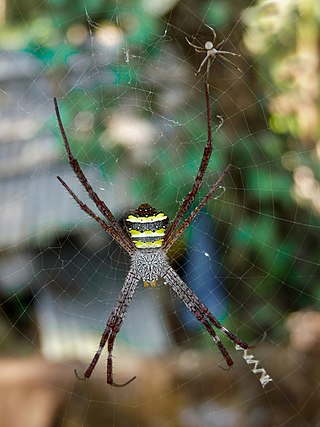
The genus Argiope includes rather large spiders that often have a strikingly coloured abdomen. These spiders are distributed throughout the world. Most countries in tropical or temperate climates host one or more species that are similar in appearance. The etymology of Argiope is from a Latin word argentum meaning silver. The carapace of Argiope species is typically covered in silvery hairs, and when crawling in the sun, they reflect it in a way that gives them a metallic, white appearance.

Heteropoda venatoria is a species of spider in the family Sparassidae, the huntsman spiders. It is native to the tropical regions of the world, and it is present in some subtropical areas as an introduced species. Its common names include giant crab spider, pantropical huntsman spider or cane spider.

Nephila is a genus of araneomorph spiders noted for the impressive webs they weave. Nephila consists of numerous species found in warmer regions around the world, although some species formerly included in the genus have been moved to Trichonephila. They are commonly called golden silk orb-weavers, golden orb-weavers, giant wood spiders, or banana spiders.

Argiope keyserlingi is a species of orb-web spider found on the east coast of Australia, from Victoria to northern Queensland. It is very similar in appearance to a closely related north Queensland species, Argiope aetherea. A. keyserlingi is commonly found in large populations in suburban parks and gardens, particularly among the leaves of Lomandra longifolia. Like many species of orb-web spiders, A. keyserlingi shows considerable sexual dimorphism, with the females being many times larger than the males. Mature females can be seen during the summer, and seeing multiple males on the web of one female is not uncommon.

The black house spider or common black spider is a common species of cribellate Australian spider, introduced to New Zealand and Japan. A closely related species, Badumna longinqua, the grey house spider, has a similar distribution, but has also been introduced to the Americas.

Argiope bruennichi, commonly known as the wasp spider, is a species of orb-weaver spider found across Central and Northern Europe, several regions of Asia, plus parts of the Middle east, North Africa and the Azores. Like many other members of the same genus Argiope, this species features distinctive yellow, white and black markings on its abdomen.

Argiope aurantia is a species of spider, commonly known as the yellow garden spider, black and yellow garden spider, golden garden spider, writing spider, zigzag spider, zipper spider, black and yellow argiope, corn spider, Steeler spider, or McKinley spider. The species was first described by Hippolyte Lucas in 1833. It is common to the contiguous United States, Hawaii, southern Canada, Mexico, and Central America. It has distinctive yellow and black markings on the abdomen and a mostly white cephalothorax. Its scientific Latin name translates to "gilded silver-face". The body length of males range from 5–9 mm (0.20–0.35 in); females range from 19–28 mm (0.75–1.10 in). These spiders may bite if disturbed or harassed, but the venom is harmless to non-allergic humans, roughly equivalent to a bumblebee sting in intensity.

Araniella cucurbitina, sometimes called the "cucumber green spider", is a spider of the family Araneidae. Araniella cucurbitina is found across Europe, Western Asia, Central Asia and Japan. The cucurbitina in the name comes from the word cucurbit which is a family of plants including cucumbers.

Zygiella x-notata, sometimes known as the missing sector orb weaver or the silver-sided sector spider, is a spider species in the family Araneidae. They are solitary spiders, residing in daily spun orb webs. Z. x-notata is a member of the genus Zygiella, the orb-weaving spiders. The adult female is easily recognized by the characteristic leaf-like mark on her posterior opisthosoma, caudal to the yellow-brown cephalothorax.

Oecobius navus is a small cosmopolitan cribellate spider species found across the world.

Nephila pilipes is a species of golden orb-web spider. It resides all over countries in East and Southeast Asia as well as Oceania. It is commonly found in primary and secondary forests and gardens. Females are large and grow to a body size of 30–50 mm, with males growing to 5–6 mm. It is the second largest of the orb-weaving spiders apart from the recently discovered Nephila komaci. The first, second, and fourth pairs of legs of juvenile females have dense hairy brushes, but these brushes disappear as the spider matures.

Larinioides sclopetarius, commonly called bridge-spider or gray cross-spider, is a relatively large orb-weaver spider with Holarctic distribution. These spiders originated in Europe, have been observed as south as the Mediterranean Coast and as north as Finland, and have been introduced to North America. They are often found on bridges, especially near light and over water. The species tends to live on steel objects and is seldom seen on vegetation. Females reach a body length of 10–14 mm, and males 8–9 mm. Their orb webs can have diameters of up to 70 cm.

Argiope catenulata, also known as the grass cross spider, is a species of orb-weaver spider ranging from India to the Philippines and Papua New Guinea, and also found in Australia in 2019. Like other species of the same genus, it builds a web with a zig-zag stabilimentum.

Argiope pulchella is a species of the orb-weaver spider family, Araneidae. Its range extends from India to China, Indochina, and Sumatra. It is a synanthropic species, often living in habitats associated with humans.

Herennia multipuncta, commonly known as the spotted coin spider, is a species of spider in the family Nephilidae native to Asia. It exhibits sexual dimorphism, the female being much larger than the male. It weaves a small web on the trunk of a tree or the wall of a building and is well camouflaged by its dappled colouration.

Argiope aemula, commonly known as the oval St Andrew's cross spider, is a species of spider in the family Araneidae which is native to southeast Asia, found from India and Sri Lanka to the Philippines, Indonesia, and Vanuatu. It is one of the giant, conspicuous "signature spider" species of the genus Argiope, observed in tropical and subtropical grasslands.

Mastophora hutchinsoni, also known as the American bolas spider, is a species of orb weaver in the genus Mastophora. The genus is distributed extensively throughout various subtropical geographical areas including Australia, South Africa, Oriental Asia, and the Americas and is not found in Europe. The hunting behavior of adult female M. hutchinsoni is unusual because they are bolas spiders. They mimic moth pheromones to attract male moths, and female M. hutchinsoni have evolved to alter their chemical release to target different moths. They then capture their prey with a sticky drop on the end of a silk line, resembling a bolas.

Argiope radon is a species of orb web spider native to Australia. It is found in tropical areas of the Northern Territory, Western Australia and Queensland. It is commonly known as the Northern St Andrew's cross spider.

Leucauge mariana is a long-jawed orb weaver spider, native to Central America and South America. Its web building and sexual behavior have been studied extensively. Males perform several kinds of courtship behavior to induce females to copulate and to use their sperm.

Salsa fuliginata, commonly known as the sooty orbweaver, is a orb-weaver spider in the genus Salsa. The species is found throughout southeastern Australia and New Zealand.





















